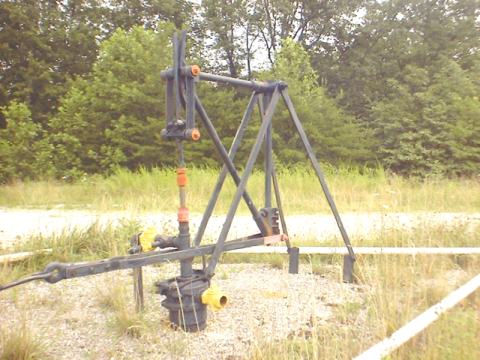
Click on the thumbnail to see a larger picture with the main parts labeled. Or, Click for a full size image (1024x768 119k jpeg)
Use the Back button to |
 |
Well head with pump jack. Rod line extends to the left |
Contact: Brandon Nuttall
Even if an oil well begins as a gusher, eventually oil produced from the well must be lifted to the surface. Early in the 20th century, it was common to build a shed in a central location and connect the pumping equipment at each well to an engine located in the shed, the "central power unit." The engine used a geared drive wheel to rotate an axle mounted near its rim. An "eccentric," mounted on a bearing on this axle, was connected to rods running to each well. As the drive wheel rotated, the eccentric orbited the center of the drive wheel without revolving, sequentially pushing and pulling each of the rods. The rod lines were often supported by A-frame devices or posts that allow the rocking motion to be transmitted along the length of the line. At the well head, the rod was attached to the back of the pump jack. The jack incorporated a fixed pivot so that the back and forth pushing was converted to an up and down lifting motion. The equipment shown here is located at the former Sun Oil Company equipment yard on Kentucky Highway 1036 along the Lee-Estill County boundary, near Standing Rock, Kentucky. It was moved to this site from leases operated by the company in the Big Sinking Oil Field.

Click on the thumbnail to see a larger picture with the main parts labeled. Or, Click for a full size image (1024x768 119k jpeg)
Use the Back button to |
 |
Well head with pump jack. Rod line extends to the left |